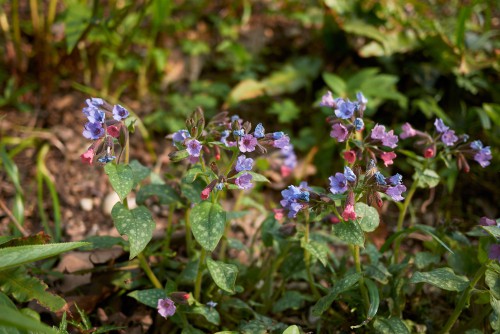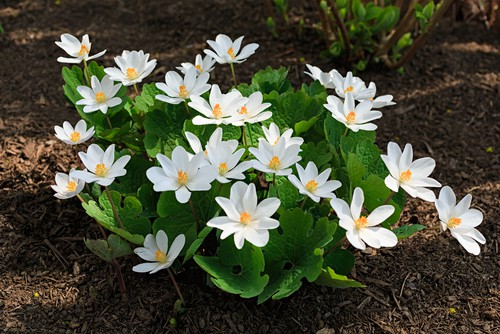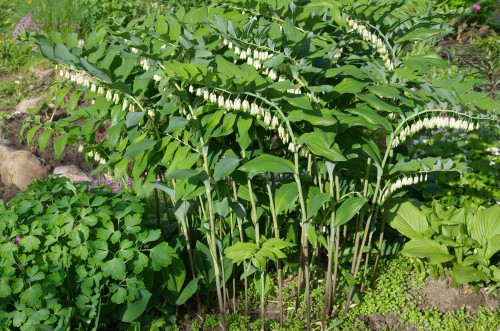Last updated on April 5th, 2022
Our site is reader supported, this means we may earn a small commission from Amazon and other affiliates when you buy through links on our site.
When you have trees in your garden, they make excellent borders, but they also block out a lot of sun for those plants underneath. What’s more, the soil under trees tends to be shady and depleted of nutrients, something that is insufficient for a lot of plants.
Not wanting to leave the space below your trees barren, there are many options for plants that will thrive throughout the year, bringing your garden a bit of colour and cheer no matter the season.
Below are ten of the best plants for under trees, divided by their varying bloom periods, so you can mix and match in such a way to receive colour and flowers all year round.
Winter flowering plants
1. Galanthus – Snowdrops

Snowdrops are the quintessential winter flower. They bloom in the coldest of weather, during January and February. They ideally need to be planted in the green for the most success and will thereafter thrive beneath the canopy of your trees, marking the turn of winter to spring with their sweet, crisp, white appearance.
Snowdrops can be purchased as bulbs, however, we always recommend looking for them in the green (as mentioned) and planted in small pots. They are a little more expensive but well worth buying this way.
2. Pulmonaria officinalis – Lungwort

Lungwort makes excellent groundcover beneath your trees. What’s more, they give bees a range of flowers with white, red, blue, purple, and pinks, all of which stand complemented by the silvery foliage. These are wildflowers that are native to Britain, and the best part is they require very little maintenance. Look for flowers appearing between February and March.
Spring flowering plants
3. Hepaticas

As the year transitions from January to February and beyond, Hepaticas make an excellent bloom. These are European flowers that prefer dappled shade beneath trees and provide blue, white, or pink flowers at the beginning of spring, usually between February and March.
4. Anemone nemorosa – Wood Anemones

The woodland Anemone nemorosa will thrive beneath your tree cover, and between March and April will give you a mass of white flowers, rich in scent. If you want to go above and beyond, look for the Vestal cultivar that produces double flowers.
5. Sanguinaria canadensis – Bloodroot

Another woodland plant, this one loves shaded areas. The blooms produced between March and April are a few centimetres off the ground, resting above clasped leaves. The flowers are comprised of rosettes of white petals.
Summer flowering plants
6. Aquilegias

Aquilegias do best in dappled shade. You can find them in many colours, and moreover, in many floral shapes. Between May and June, your garden will burst with colour. These are perfect for cottage or woodland gardens and they self-seed quite well, so you don’t have to do much work to keep them going in your garden.
7. Lunaria annua – Honesty

Known commonly as Honesty, the Lunaria annua produces pretty flowers at the end of spring and the start of summer that is rich in nectar. They will bring forth many pollinators to your garden. Eventually, you get seed heads that are stunning and remain in place throughout the winter.
8. Polygonatum × hybridum – Solomon’s Seal

These flowers are elegant with white flowers boasting green tips arched atop lush foliage. They prefer shaded spots with moist soil. Flowering takes place between May and June, and once that is over, look for the blackberry-type fruits and the subsequent birds they summon.
9. Galium odoratum – Sweet Woodruff

This plant loves damp shade, although if the area beneath your trees is dry, it will cope. If you have a woodland setting, these plants are perfect among your shrubs. They will make a carpet of flowers between May and June.
Autumn flowering plants
10. Hardy Geraniums – Cranesbills

These plants flower between May and October, with a bright range of colours for months on end. They will self-seed, so you don’t have to do any work to generate new plants.
By mixing and matching any of these top 10 plants, you can make sure the area beneath your trees doesn’t remain vacant for long but instead is bursting with colour.


